The Meat Swap That Gives Beef Bourguignon Even More Rich Flavors
When cold weather strikes, foodies start turning their attention toward hearty stews — and for centuries, classic beef bourguignon has fit the bill. If you've never made it before, beef bourguignon is a traditional French stew in a red wine sauce. It packs double meat with chunks of tender beef and crispy bacon, bulked up by pearl onions, cremini mushrooms, carrots, and thyme. To give this longtime favorite an updated facelift, swap bacon out and use other cured pork like pancetta or guanciale for a richer, more complex flavor profile. You might recognize pancetta from classic pasta dishes like pasta e fagioli and guanciale from pasta alla gricia. But, these flavorful cuts are far from one-trick ingredients, and they belong in more than just your pasta dishes.
Pancetta is salt-cured pork belly. It comes from the same part of the pig as bacon, but where bacon is crispy and smoky, pancetta is not smoked — instead featuring a deep, strong, pork-forward flavor. That ultra-savory profile is complemented by a hefty level of saltiness, which means home cooks have less work to do when seasoning a finished dish that incorporates the ingredient. Similarly, guanciale is cured, spiced, dried pork jowl that's made via the same process as pancetta, but from a fattier cut of meat, which can perform especially well for rendering the beef chunks and veggies in your bourguignon.
Replace the bacon with toothy pancetta or rich guanciale
Both pancetta and guanciale are aged and fully cured, so they don't need to be cooked to be safely eaten. Although, while these salty meats can totally be enjoyed straight out of the package, they perform best in your beef bourguignon after a quick saute to render some of the fat off into crispy morsels. To incorporate it into your lush beef bourguignon, simply use the pancetta or guanciale the same way you might use the bacon in your regular recipe for the stew. Sautee the cubed meat in the bottom of a Dutch oven or large pot, gently render off the fat, then remove the cubes from the pot using a slotted spoon and reserve for later. You can brown the beef chunks in all that flavorful rendered fat, then add the veggies, broth, and cooked pancetta or guanciale on top to assemble the slow-cooking stew.
Thin-sliced uncooked pancetta and guanciale are typically served on charcuterie boards, while the raw cubed versions are the more common choices for cooking. Some grocery store deli sections might carry these meats, but cooking with pancetta and guanciale can also make a great excuse for swinging by your local butcher shop or specialty Italian larder. In addition to salt, pancetta is also sometimes cured in flavorful spices like clove, nutmeg, cinnamon, and black pepper; this spiced variety would work well in beef bourguignon to add warming sweet-spiced dimensionality.

